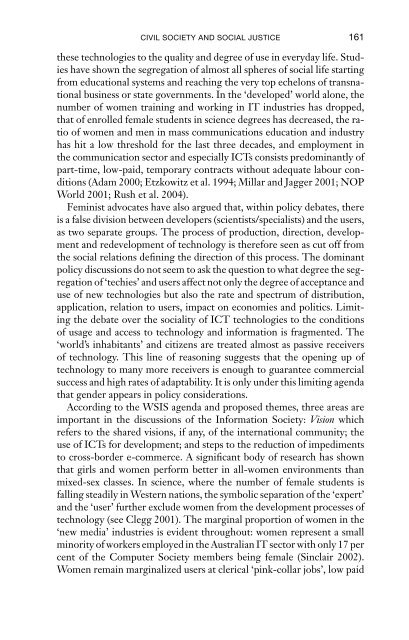Media Policy and Globalization - Blogs Unpad
Media Policy and Globalization - Blogs Unpad
Media Policy and Globalization - Blogs Unpad
You also want an ePaper? Increase the reach of your titles
YUMPU automatically turns print PDFs into web optimized ePapers that Google loves.
CIVIL SOCIETY AND SOCIAL JUSTICE 161<br />
these technologies to the quality <strong>and</strong> degree of use in everyday life. Studies<br />
have shown the segregation of almost all spheres of social life starting<br />
from educational systems <strong>and</strong> reaching the very top echelons of transnational<br />
business or state governments. In the ‘developed’ world alone, the<br />
number of women training <strong>and</strong> working in IT industries has dropped,<br />
that of enrolled female students in science degrees has decreased, the ratio<br />
of women <strong>and</strong> men in mass communications education <strong>and</strong> industry<br />
has hit a low threshold for the last three decades, <strong>and</strong> employment in<br />
the communication sector <strong>and</strong> especially ICTs consists predominantly of<br />
part-time, low-paid, temporary contracts without adequate labour conditions<br />
(Adam 2000; Etzkowitz et al. 1994; Millar <strong>and</strong> Jagger 2001; NOP<br />
World 2001; Rush et al. 2004).<br />
Feminist advocates have also argued that, within policy debates, there<br />
is a false division between developers (scientists/specialists) <strong>and</strong> the users,<br />
as two separate groups. The process of production, direction, development<br />
<strong>and</strong> redevelopment of technology is therefore seen as cut off from<br />
the social relations defining the direction of this process. The dominant<br />
policy discussions do not seem to ask the question to what degree the segregation<br />
of ‘techies’ <strong>and</strong> users affect not only the degree of acceptance <strong>and</strong><br />
use of new technologies but also the rate <strong>and</strong> spectrum of distribution,<br />
application, relation to users, impact on economies <strong>and</strong> politics. Limiting<br />
the debate over the sociality of ICT technologies to the conditions<br />
of usage <strong>and</strong> access to technology <strong>and</strong> information is fragmented. The<br />
‘world’s inhabitants’ <strong>and</strong> citizens are treated almost as passive receivers<br />
of technology. This line of reasoning suggests that the opening up of<br />
technology to many more receivers is enough to guarantee commercial<br />
success <strong>and</strong> high rates of adaptability. It is only under this limiting agenda<br />
that gender appears in policy considerations.<br />
According to the WSIS agenda <strong>and</strong> proposed themes, three areas are<br />
important in the discussions of the Information Society: Vision which<br />
refers to the shared visions, if any, of the international community; the<br />
use of ICTs for development; <strong>and</strong> steps to the reduction of impediments<br />
to cross-border e-commerce. A significant body of research has shown<br />
that girls <strong>and</strong> women perform better in all-women environments than<br />
mixed-sex classes. In science, where the number of female students is<br />
falling steadily in Western nations, the symbolic separation of the ‘expert’<br />
<strong>and</strong> the ‘user’ further exclude women from the development processes of<br />
technology (see Clegg 2001). The marginal proportion of women in the<br />
‘new media’ industries is evident throughout: women represent a small<br />
minority of workers employed in the Australian IT sector with only 17 per<br />
cent of the Computer Society members being female (Sinclair 2002).<br />
Women remain marginalized users at clerical ‘pink-collar jobs’, low paid

















